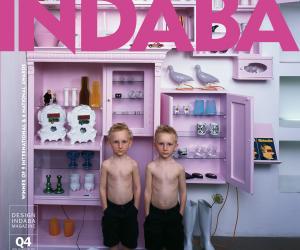First Published in
Ironically fusing the Czech Republic’s glass and porcelain heritage with the post-Communism consumer rush has given Maxim Velcovsky an international reputation. His work is characterised by giving familiar forms witty new functions and identities. Due to appear at Design Indaba 2008, he talks to us about the UP Závody collection, authenticity, kitsch, mass production and the Czech Republic.
Design Indaba: Apparently you’re a comic book artist, advertising model, magazine editor, scriptwriter, porcelain designer, interiors designer and furniture designer. That’s a lot of guises to keep going!
Maxim Velcovsky: [laughs] Actually, you should also now add artistic director because I am compiling the new collection for UP Závody.
Yes, you just launched that range at Prague’s designblok 07. Tell us more about it.
UP Závody was founded in the 1920s and was actually one of the biggest design companies in Europe. They were doing fantastic pieces, but then with Communism it became state property and they started making what was called sector furniture; exporting tons of ordinary shaped furniture to Russia. Five trains of furniture for uniform blocks of flats would leave for the Russian market every day. It became a symbol of the socialist approach.
The new owners who have bought the company again after so many years want to come back with the old traditional label, incorporating a new direction and context. They asked me to be the art director and come up with fresh ideas and designers.
In the previous edition of the magazine, we had Tom Dixon explaining a similar project in which he is involved with the iconic Artek company in Finland. Is there a trend towards revitalising old factories through design?
I think it’s a response towards people moving manufacturing to China because it’s cheaper. For instance, with my company Qubus, which was founded five years ago, we still produce stuff here in the Czech Republic because we think it’s important to connect local craftsmanship with the local identity and energy. We prefer to make the stuff in the country that we grew up in as it supports the identity of the work. It would be very difficult to move the know-how and traditions to China and just become a European think tank. The stuff that is made here is symbolic for the people who live here.
What is interesting about continuing UP Závody’s original tradition is that the context is different. People don’t buy whole living rooms from one company nowadays, but rather individual pieces from different companies. So we’ve made solitary pieces for interiors, with a few pieces from the original collection and the rest by new designers.
Is this new approach to furniture shopping a characteristic of a new generation in the Czech Republic?
With Ikea, a new approach came in because people started buying cheap furniture. Still, Ikea was an educator because they were doing cheap copies of good design. When the Ikea model breaks in two years time, they might buy something more solid from quality companies. Design is still seen as something expensive, so people buy what they can afford.
Would you like design to be cheaper, more widespread and easier to access?
Of course. It’s always nice to design something for the mass market because the impact is bigger and you’re solving different problems than when making more unique pieces. The challenges are different too – pieces should be easily produced and have a certain quality.
A lot of your work flirts with the notion of kitsch. Does mass-produced design tend towards a definition of kitsch as popular taste?
Well, I’m playing with kitsch but I can’t really describe what it is. Tomas Kulka tried to describe what kitsch is. His exploration of kitsch is a great work, but it’s hard for me to describe it. I use clichéd things and try to say something through exploring kitsch things, but I can’t say what it is exactly – also because my experience is different.
I don´t actually know if there is a universal type of kitch – it is also about the process behind the object, which we can´t see from the first moment. For example, mass production is a very important phenomenon in terms of kitsch.
For instance, Digi Clock with the digital clock display on top of the florid clock combines an old porcelain body with a high-tech thing, which signifies that time still passes and people still love kitsch pieces and need them. People spend time making them and I shouldn’t be the one to say that it’s wrong. This is actually quite an important topic for me, but I think people need more information. For instance, it’s often hard to say if something is kitsch or naïve. I spend a lot of time in factories where these shapes are produced and I ask myself what is right and what is wrong.
Milan Kundera also wrote a lot about kitsch. Is your exploration of kitsch connected to the history of socialism in Czechoslovakia?
Kundera is quite a philosopher and explored kitsch in a few of his works in the context of his own experience, as well as how kitsch can be a moral or political issue, and even a lifestyle. Kitsch is definitely part of Eastern Europe. During socialism, there just wasn’t choice available on the market. Many people had weekend homes in the country where they would make these things. I focus on 3D objects that are called kitsch and also on the DIY phenomenon.
In my work, I use the blue onion decoration quite often, which is actually older than our way of so-called Communism, but each period incorporates the traditional ornamental things from the past. I used this decoration on a bust of Lenin (called Ornament and Crime) and when people see the blue flowers, they completely forget what is behind the ornamentation. This is the same thing with design – you can put decoration or ornament on whatever and people will like it for what’s on the surface, a kind of fake beauty. It also represents the totalitarian system, you live and get used to it, forgetting about the background.
What is the significance of using porcelain?
I used porcelain throughout school, in secondary school and acedemia, for 11 years in total, which is why I decided to make it my area of design. However, I wanted to make something different to the typically geometric pieces and come up with a new approach because ceramics in our country is associated with making kitsch things for tourists. Students studying porcelain have no future because the factories don’t want new designs and new designs take two years to make.
So I made a work that described this situation – the Wellington Boot. It’s about how the context needs to change. Usually a boot keeps water out but, as a vase, the boot keeps water in. So, I’m also playing with the notion that “form follows function” because if you change the material and the context, you have a completely different object. I hope that the stories behind my work make people realise something.
It also again talks about your interest in ironically recontextualising objects from the socialist heritage within a contemporary context. You said in one interview that with the change to democracy, objects got different names overnight.
We are a generation that was not influenced by Nintendo Play Stations, computers, internet, porn magazines or Coca-Cola. We were very pure in nature and had to improvise, carving our own guns out of wood and playing games we invented. It was our dream to drink Coca-Cola and we used to collect cans from the Embassy rubbish bins. We kept these collections in our living rooms. After the revolution came the supermarket avalanche and from one day to the next we had everything. In a way, we had the revolution so that we could drink Coke.
This is my strange theory of democracy: We wanted freedom to be able to buy everything – unlike my parents’ generation, which wanted freedom of speech and movement. I always like to compare these two systems by using objects from my childhood. For instance, my Trabant car as a candleholder. My father’s first car was a Trabant and, for example, people in Eastern Germany used to have to wait 15 years for such a car. When you were born, they put you on the waiting list.
So one could say that your objects offer alternative consumer symbols to Coke and McDonald's for the Czech Republic’s democracy?
Before the revolution, “The Soviet Union Forever” or “Communist Party: The Strongest Gun in the Pants of Workers” was written on the buildings. With the revolution, these were replaced with slogans like “Phillips: Let’s Make Things Better” or “Always Coca-Cola”. In some way, we were in the same context again after so many years. Of course democracy is the best political system invented so far and I get the freedom to design what I want to. Still, I do like to test and describe the situation through design. People shouldn’t see my things as nostalgic.
You’re only 31 and yet you are consistently described as “the saviour of the Czech porcelain industry” and one of the “leading Czech designers”. How did you establish yourself as a leading Czech designer?
Well, actually I think one of the biggest names in terms of design in our country is Borek Sipek and he’s the king of design. As for me, it’s kind of a mystery. I finished school in 2002 with an unpractical diploma, because I had done many separate items that did not constitute a collection. The pieces were more social critiques than pure design objects. I heard about Jakub Berdych who ran what was in those days the Qubus Gallery and I asked him to exhibit my work. He thought the work looked quite different, agreed and actually sold it all. We decided to go to the factory and try to produce the work ourselves, which is how Qubus became a studio and shop.
Since then we have been working together. We were actually the first design shop in Prague and it took us four years to earn some money. Over the years, companies have started approaching us and we’re doing more and more industrial and interior work. But I can’t limit myself to just making design, I have to work in more media than one. I’m also writing a screenplay for a sitcom with some friends of mine.
Tell us about the two ranges you designed for the Mint Gallery in London recently, Delicatessen and Catastrophe.
Delicatessen is about still-lives connected to the process of eating and the tradition of tableware. Each piece is unique. For Catastrophe, I became really fascinated by how, when archeologists find something, it’s covered with sand and they don’t know what it is yet. So I decided to leave the designs covered with dirt and clay, as a surprise. The shape and decoration is hidden and it becomes an anti-design object. It could be a piece that you find after some catastrophe, but in this case you respect the mystery of what the object actually is.




































